Determined absorption coefficient of 85Rb atom in the y-configuration
The manipulation of subluminal and superluminal light propagation in optical medium
has attracted many attentions due to its potential applications during the last decades, such as
controllable optical delay lines, optical switching [2], telecommunication, interferometry,
optical data storage and optical memories quantum information processing, and so on [6].
The most important key to manipulate subluminal and superluminal light propagations lies in
its ability to control the absorption and dispersion properties of a medium by a laser field.
As we know that coherent interaction between atom and light field can lead to
interesting quantum interference effects such as electromagnetically induced transparency
(EIT) [1]. The EIT is a quantum interference effect between the probability amplitudes that
leads to a reduction of resonant absorption for a weak probe light field propagating through a
medium induced by a strong coupling light field [5]. Basic configurations of the EIT effect
are three-level atomic systems including the -Ladder and V-type configurations. In each
configuration, the EIT efficiency is different, in which the -type configuration is the best,
whereas the V-type configuration is the worst [4], [7], therefore, the manipulation of light in
each configuration are also different. This suggests that we choose to use the analytical model
to determine the absorption coefficient for the Y configuration of the 85Rb atomic system.
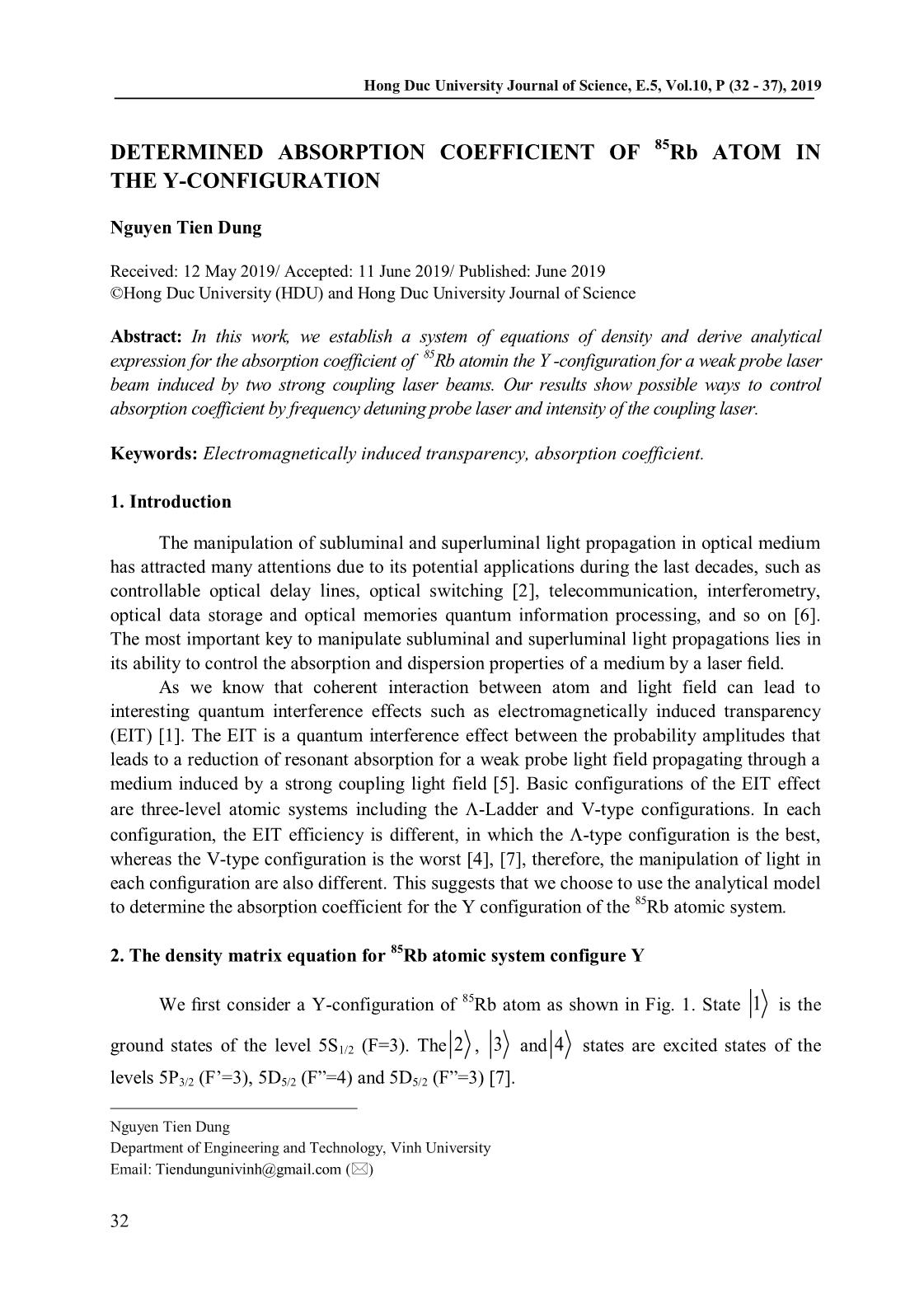
Trang 1
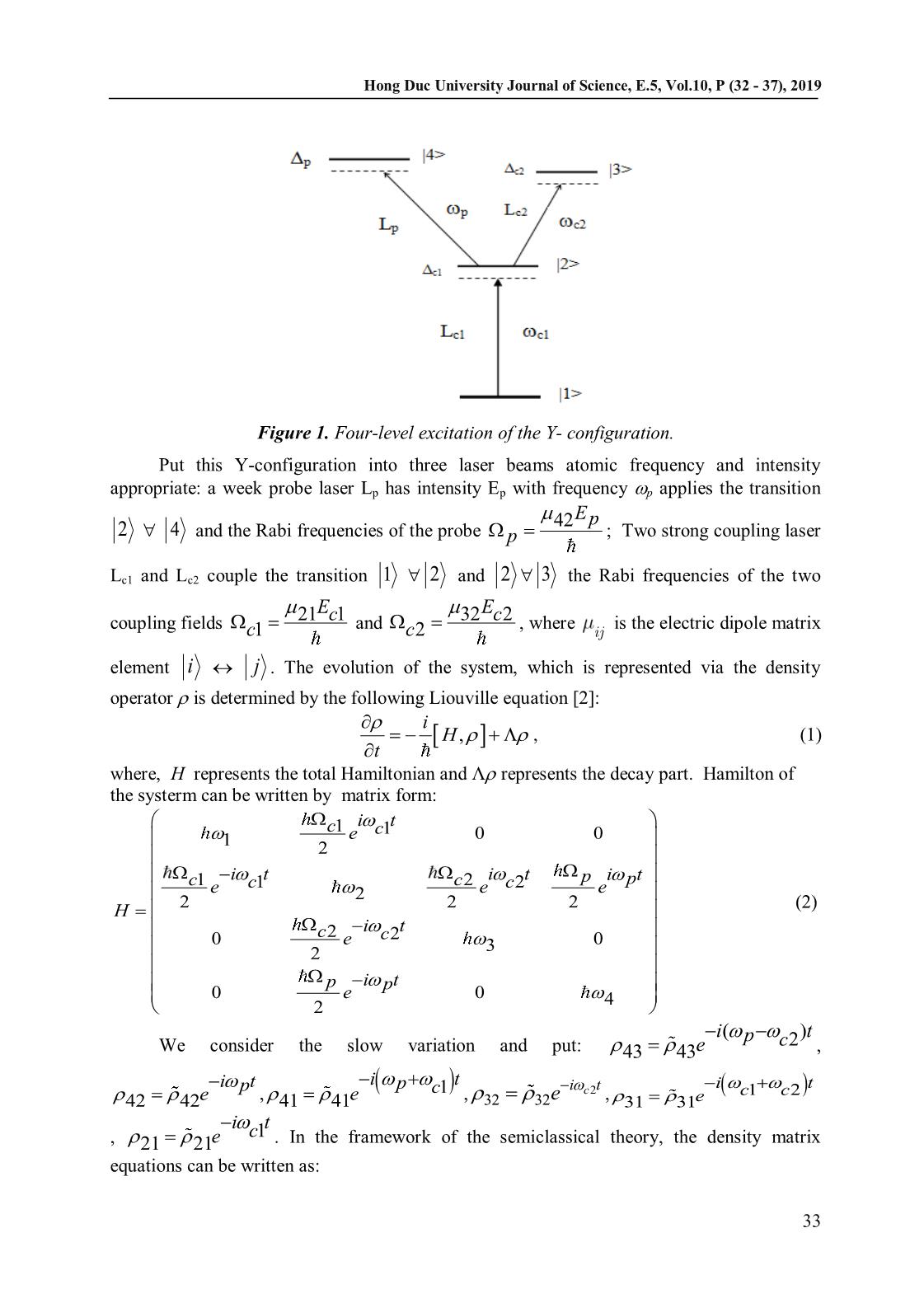
Trang 2
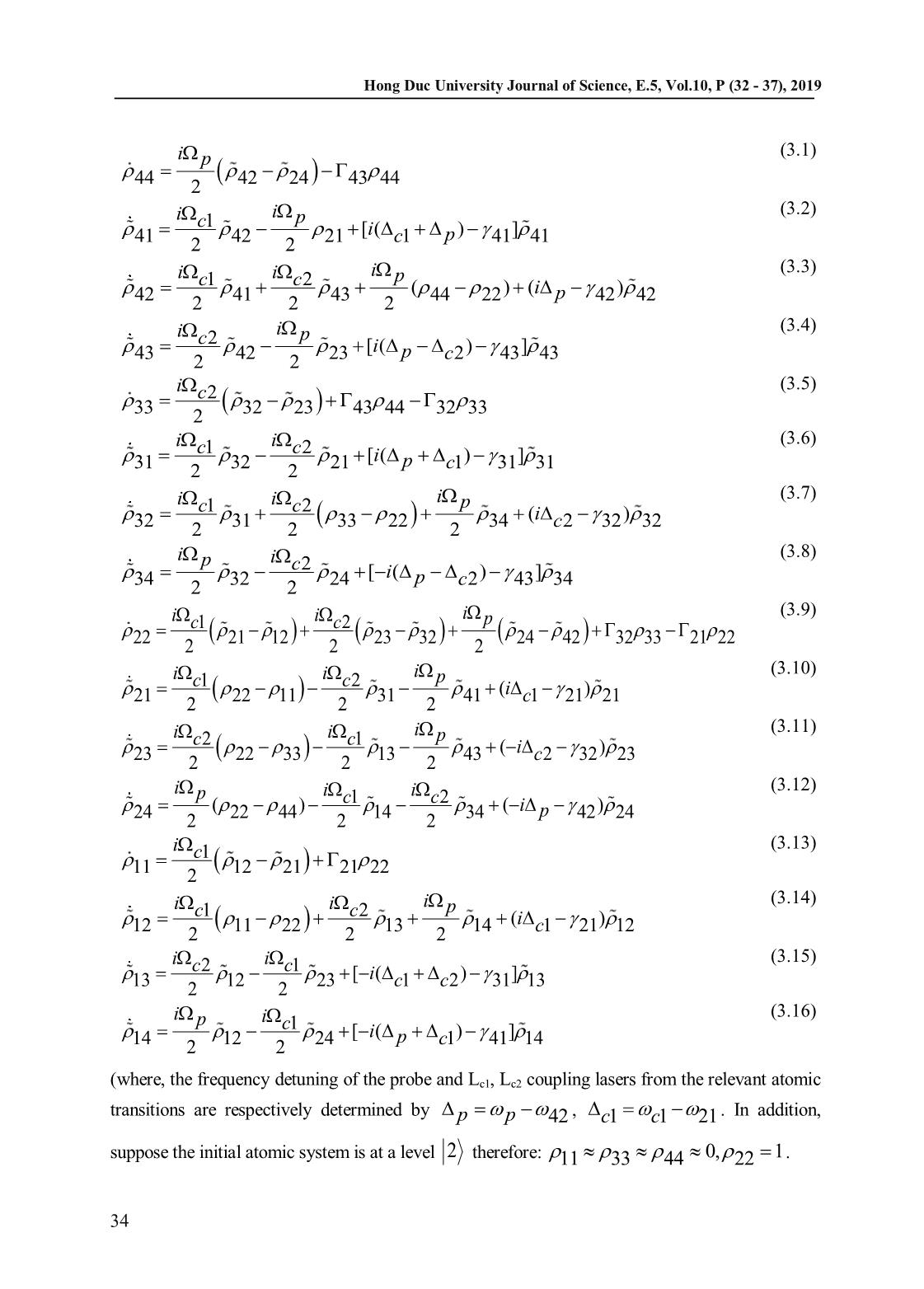
Trang 3
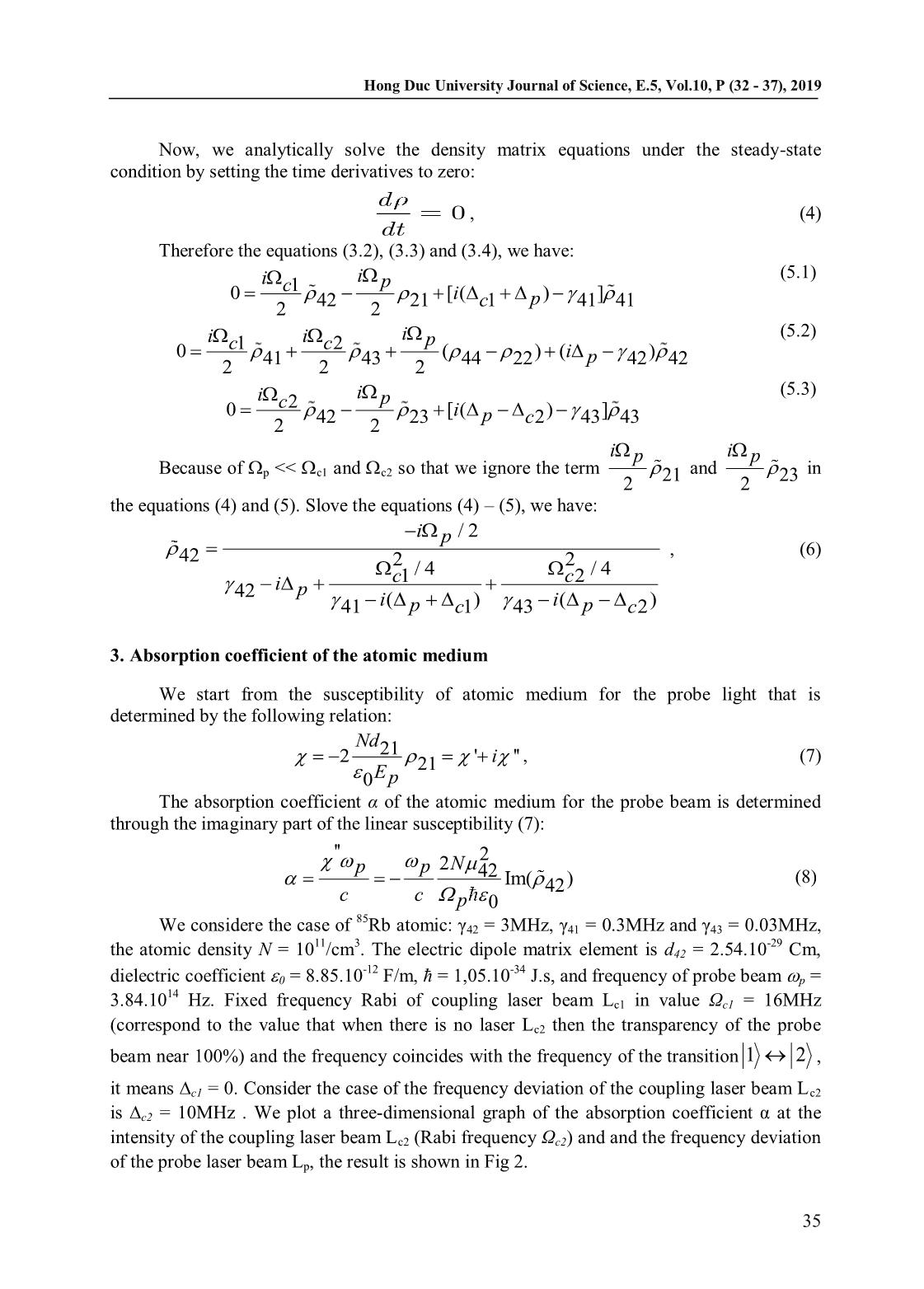
Trang 4
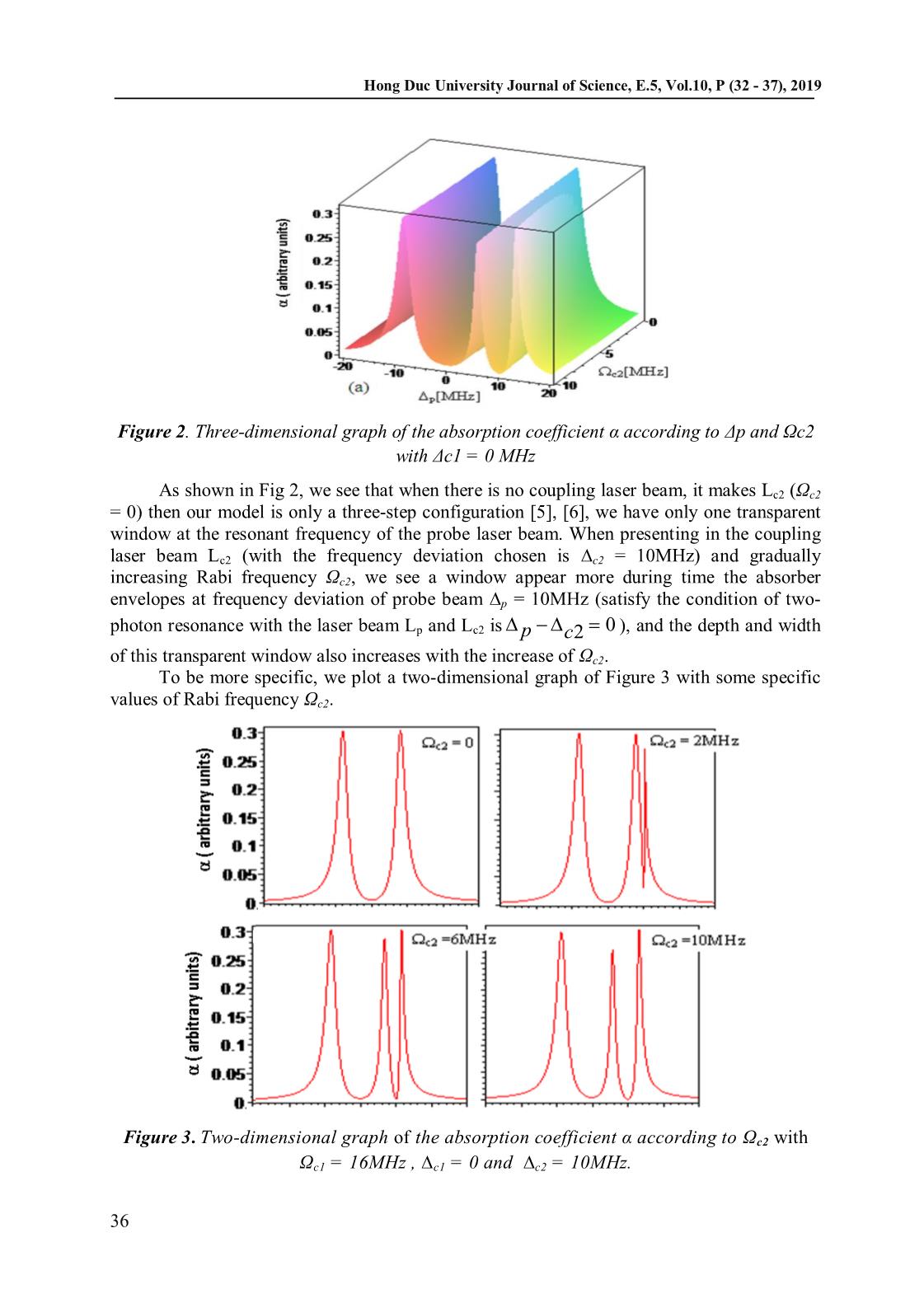
Trang 5
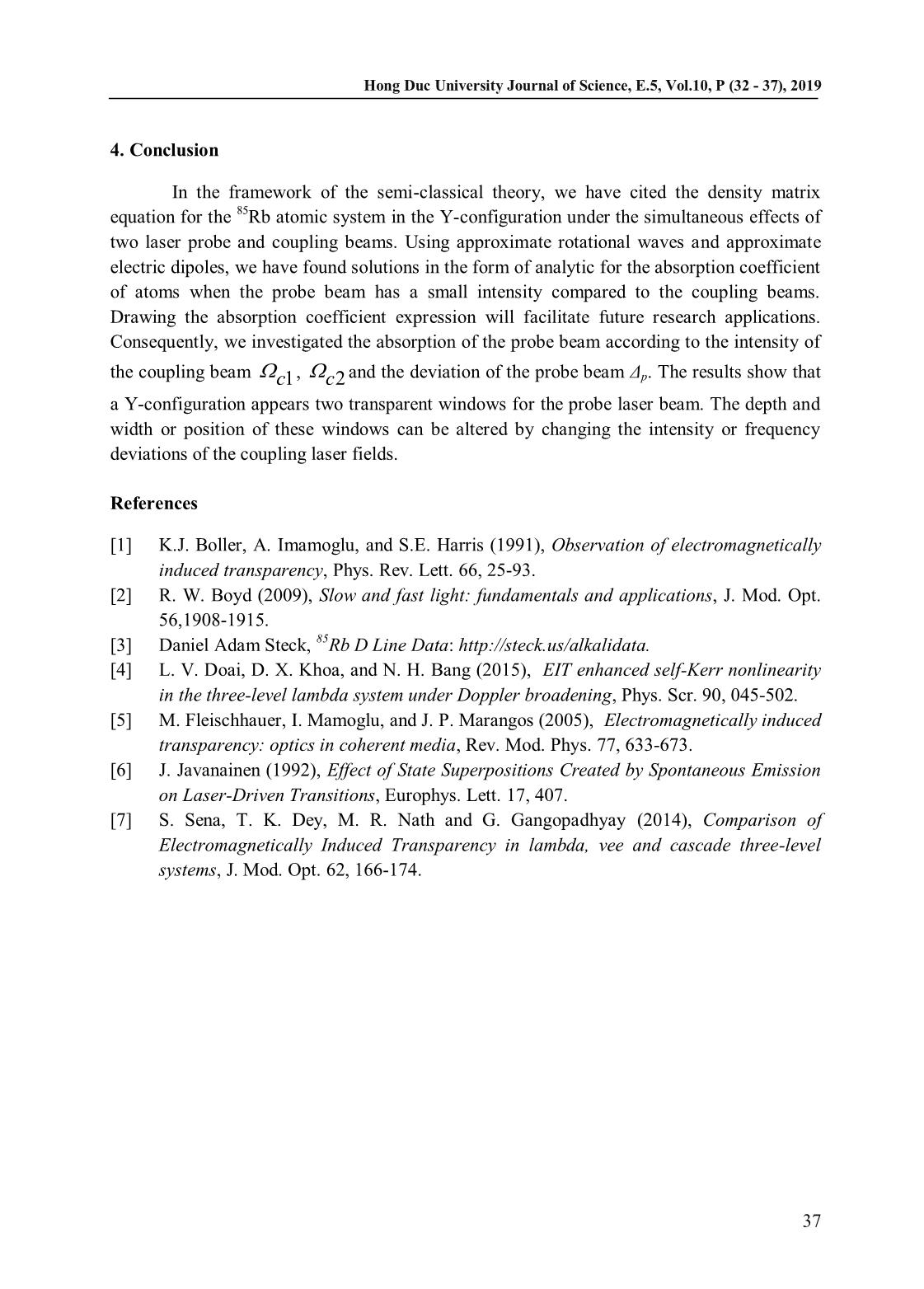
Trang 6
Tóm tắt nội dung tài liệu: Determined absorption coefficient of 85Rb atom in the y-configuration
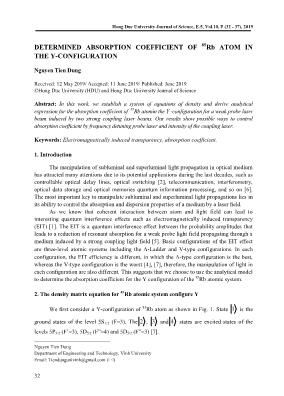
Hong Duc University Journal of Science, E.5, Vol.10, P (32 - 37), 2019 DETERMINED ABSORPTION COEFFICIENT OF 85Rb ATOM IN THE Y-CONFIGURATION ofFac. Grad. Studies, Mahidol Univ. M.M. (International Hospitality Management) / Nguyen Tien Dung1 Received: 12 May 2019/ Accepted: 11 June 2019/ Published: June 2019 ©Hong Duc University (HDU) and Hong Duc University Journal of Science Abstract: In this work, we establish a system of equations of density and derive analytical expression for the absorption coefficient of 85Rb atomin the Y -configuration for a weak probe laser beam induced by two strong coupling laser beams. Our results show possible ways to control absorption coefficient by frequency detuning probe laser and intensity of the coupling laser. Keywords: Electromagnetically induced transparency, absorption coefficient. 1. Introduction The manipulation of subluminal and superluminal light propagation in optical medium has attracted many attentions due to its potential applications during the last decades, such as controllable optical delay lines, optical switching [2], telecommunication, interferometry, optical data storage and optical memories quantum information processing, and so on [6]. The most important key to manipulate subluminal and superluminal light propagations lies in its ability to control the absorption and dispersion properties of a medium by a laser field. As we know that coherent interaction between atom and light field can lead to interesting quantum interference effects such as electromagnetically induced transparency (EIT) [1]. The EIT is a quantum interference effect between the probability amplitudes that leads to a reduction of resonant absorption for a weak probe light field propagating through a medium induced by a strong coupling light field [5]. Basic configurations of the EIT effect 32 are three-level atomic systems including the -Ladder and V-type configurations. In each configuration, the EIT efficiency is different, in which the -type configuration is the best, whereas the V-type configuration is the worst [4], [7], therefore, the manipulation of light in each configuration are also different. This suggests that we choose to use the analytical model to determine the absorption coefficient for the Y configuration of the 85Rb atomic system. 2. The density matrix equation for 85Rb atomic system configure Y We first consider a Y-configuration of 85Rb atom as shown in Fig. 1. State 1 is the ground states of the level 5S1/2 (F=3). The 2 , 3 and 4 states are excited states of the levels 5P3/2 (F‟=3), 5D5/2 (F”=4) and 5D5/2 (F”=3) [7]. Nguyen Tien Dung Department of Engineering and Technology, Vinh University Email: Tiendungunivinh@gmail.com ( ) 32 Hong Duc University Journal of Science, E.5, Vol.10, P (32 - 37), 2019 Fac. ofFac. Grad. Studies, Mahidol Univ.M.M. (International Hospitality Management) / Figure 1. Four-level excitation of the Y- configuration. Put this Y-configuration into three laser beams atomic frequency and intensity appropriate: a week probe laser Lp has intensity Ep with frequency p applies the transition 42Ep 2 4 and the Rabi frequencies of the probe p ; Two strong coupling laser Lc1 and Lc2 couple the transition 1 2 and 3 the Rabi frequencies of the two 21Ec 1 32Ec 2 coupling fields c1 and c2 , where ij is the electric dipole matrix element i j . The evolution of the system, which is represented via the density operator is determined by the following Liouville equation [2]: i H, , (1) t where, H represents the total Hamiltonian and Λ represents the decay part. Hamilton of 33 the systerm can be written by matrix form: c1 itc1 1 e 00 2 cc12 icc12 t i t p itp e2 e e H 2 2 2 (2) it 00c2 e c2 2 3 p itp 00e 2 4 it()p c2 We consider the slow variation and put: 43 43e , it it p p c1 itc2 it cc12 42 42e , 41 41e , 32 32e , 31 31e itc1 , 21 21e . In the framework of the semiclassical theory, the density matrix equations can be written as: 33 Hong Duc University Journal of Science, E.5, Vol.10, P (32 - 37), 2019 i p (3.1) 442 42 24 43 44 ofFac. Grad. Studies, Mahidol Univ. M.M. (International Hospitality Management) / (3.2) ic1 i p [()]i p 4122 42 21c 1 41 41 (3.3) iicc12i p ()() i p 422 41 2 43 2 44 22 42 42 (3.4) ic2 i p [()]i p 4322 42 23c 2 43 43 i (3.5) c2 332 32 23 43 44 32 33 iicc12 (3.6) [()]i p 3122 32 21c 1 31 31 ii i p (3.7) cc12 ()i 322 31 2 33 22 2 34c 2 32 32 (3.8) i p ic2 [()] i p 3422 32 24c 2 43 34 iiip (3.9) cc12 222 21 12 2 23 32 2 24 42 32 33 21 22 iii p (3.10) cc12 ()i 212 22 11 2 31 2 41c 1 21 21 iii p (3.11) cc21 () i 232 22 33 2 13 2 43c 2 32 23 i (3.12) 34 p iicc12 ()() i p 242 22 44 2 14 2 34 42 24 i (3.13) c1 112 12 21 21 22 iii p (3.14) cc12 ()i 122 11 22 2 13 2 14c 1 21 12 ii (3.15) cc21 [()] i 1322 12 23cc 1 2 31 13 (3.16) i p ic1 [()] i p 1422 12 24c 1 41 14 (where, the frequency detuning of the probe and Lc1, Lc2 coupling lasers from the relevant atomic transitions are respectively determined by pp 42 , cc1 1 21. In addition, suppose the initial atomic system is at a level 2 therefore: 11 33 44 0, 22 1. 34 Hong Duc University Journal of Science, E.5, Vol.10, P (32 - 37), 2019 Now, we analytically solve the density matrix equations under the steady-state condition by setting the time derivatives to zero: Fac. ofFac. Grad. Studies, Mahidol d 0 , (4) dt Therefore the equations (3.2), (3.3) and (3.4), we have: (5.1) ic1 i p 0 [i ( p ) ] 2242 21c 1 41 41 (5.2) iicc12i p 0 ( ) (i p ) 241 2 43 2 44 22 42 42 (5.3) i i c2 p Univ.M.M. (International Hospitality Management) / 0 [i ( p ) ] 2242 23c 2 43 43 i p i p Because of p << c1 and c2 so that we ignore the term and in 2 21 2 23 the equations (4) and (5). Slove the equations (4) – (5), we have: i p /2 , (6) 42 22 cc12/ 4 / 4 42 i p 41 ii()() pp cc 1 43 2 3. Absorption coefficient of the atomic medium We start from the susceptibility of atomic medium for the probe light that is determined by the following relation: Nd 221 ' i '' , (7) E 21 0 p 35 The absorption coefficient α of the atomic medium for the probe beam is determined through the imaginary part of the linear susceptibility (7): '' 2 pp 2N42 Im(42 ) (8) ccp 0 85 We considere the case of Rb atomic: γ42 = 3MHz, γ41 = 0.3MHz and γ43 = 0.03MHz, 11 3 -29 the atomic density N = 10 /cm . The electric dipole matrix element is d42 = 2.54.10 Cm, -12 -34 dielectric coefficient 0 = 8.85.10 F/m, ħ = 1,05.10 J.s, and frequency of probe beam p = 14 3.84.10 Hz. Fixed frequency Rabi of coupling laser beam Lc1 in value Ωc1 = 16MHz (correspond to the value that when there is no laser Lc2 then the transparency of the probe beam near 100%) and the frequency coincides with the frequency of the transition 12 , it means ∆c1 = 0. Consider the case of the frequency deviation of the coupling laser beam Lc2 is ∆c2 = 10MHz . We plot a three-dimensional graph of the absorption coefficient α at the intensity of the coupling laser beam Lc2 (Rabi frequency Ωc2) and and the frequency deviation of the probe laser beam Lp, the result is shown in Fig 2. 35 Hong Duc University Journal of Science, E.5, Vol.10, P (32 - 37), 2019 Fac. ofFac. Grad. Studies, Mahidol Univ. M.M. (International Hospitality Management) / Figure 2. Three-dimensional graph of the absorption coefficient α according to Δp and Ωc2 with Δc1 = 0 MHz As shown in Fig 2, we see that when there is no coupling laser beam, it makes Lc2 (Ωc2 = 0) then our model is only a three-step configuration [5], [6], we have only one transparent window at the resonant frequency of the probe laser beam. When presenting in the coupling laser beam Lc2 (with the frequency deviation chosen is ∆c2 = 10MHz) and gradually increasing Rabi frequency Ωc2, we see a window appear more during time the absorber envelopes at frequency deviation of probe beam ∆p = 10MHz (satisfy the condition of two- photon resonance with the laser beam Lp and Lc2 is p c2 0 ), and the depth and width of this transparent window also increases with the increase of Ωc2. To be more specific, we plot a two-dimensional graph of Figure 3 with some specific values of Rabi frequency Ωc2. 36 Figure 3. Two-dimensional graph of the absorption coefficient α according to Ωc2 with Ωc1 = 16MHz , ∆c1 = 0 and ∆c2 = 10MHz. 36 Hong Duc University Journal of Science, E.5, Vol.10, P (32 - 37), 2019 4. Conclusion In the framework of the semi-classical theory, we have cited the density matrix ofFac. Grad. Studies, Mahidol equation for the 85Rb atomic system in the Y-configuration under the simultaneous effects of two laser probe and coupling beams. Using approximate rotational waves and approximate electric dipoles, we have found solutions in the form of analytic for the absorption coefficient of atoms when the probe beam has a small intensity compared to the coupling beams. Drawing the absorption coefficient expression will facilitate future research applications. Consequently, we investigated the absorption of the probe beam according to the intensity of the coupling beam c1, c2 and the deviation of the probe beam Δp. The results show that a Y-configuration appears two transparent windows for the probe laser beam. The depth and Univ.M.M. (International Hospitality Management) / width or position of these windows can be altered by changing the intensity or frequency deviations of the coupling laser fields. References [1] K.J. Boller, A. Imamoglu, and S.E. Harris (1991), Observation of electromagnetically induced transparency, Phys. Rev. Lett. 66, 25-93. [2] R. W. Boyd (2009), Slow and fast light: fundamentals and applications, J. Mod. Opt. 56,1908-1915. [3] Daniel Adam Steck, 85Rb D Line Data: [4] L. V. Doai, D. X. Khoa, and N. H. Bang (2015), EIT enhanced self-Kerr nonlinearity in the three-level lambda system under Doppler broadening, Phys. Scr. 90, 045-502. [5] M. Fleischhauer, I. Mamoglu, and J. P. Marangos (2005), Electromagnetically induced transparency: optics in coherent media, Rev. Mod. Phys. 77, 633-673. [6] J. Javanainen (1992), Effect of State Superpositions Created by Spontaneous Emission 37 on Laser-Driven Transitions, Europhys. Lett. 17, 407. [7] S. Sena, T. K. Dey, M. R. Nath and G. Gangopadhyay (2014), Comparison of Electromagnetically Induced Transparency in lambda, vee and cascade three-level systems, J. Mod. Opt. 62, 166-174. 37
File đính kèm:
 determined_absorption_coefficient_of_85rb_atom_in_the_y_conf.pdf
determined_absorption_coefficient_of_85rb_atom_in_the_y_conf.pdf

